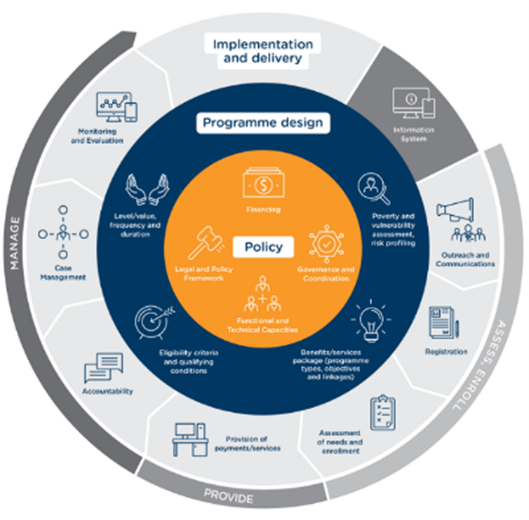Investing in social protection after COVID-19: Three lessons learnt
Discussion details

COVID-19 has had an unprecedented socio-economic impact on populations and devastating consequences for the poor and vulnerable worldwide – eroding progress made in recent years.1 The effects are wide-ranging and long-lasting. In the poorest countries of the world, the continuing impacts of COVID-19 are further exacerbated by the Ukraine crisis and its ripple effects (e.g. on food and fuel).2
The little told headline story of these past three years is the role that social protection systems have played in responding to – and mitigating the impacts of – the crisis, via the largest scale-up in history.3 The story needs to be told, as the lessons emerging from that global response could affect our ability to prepare for, respond to and withstand the multiple and overlapping shocks and challenges that lie ahead of us. So, what are these lessons learnt?4
Lessons learnt – Social protection: from a short-term COVID-19 response to a medium/long-term perspective
- Countries with established and inclusive social protection programmes, which could leverage and adapt, fared much better than those that had to build or drastically expand programmes during the crisis.
- The underlying institutions, capacities and delivery systems, which served social protection programmes, acted as ‘building blocks’ to support their response.
- Factoring risks and shocks into social protection system design, and better collaboration with the humanitarian and disaster risk management (DRM) sectors, will be critical.
Figure 1 Social protection as a ‘system’
Social protection is a key ‘anticipatory action’ when it comes to shocks. In countries where a high percentage of people were already protected pre-COVID-19, via programmes providing adequate support to a high percentage of population in need, the effects of the crisis were intrinsically mitigated.5 Moreover, evidence shows the more inclusive the approach of an intervention prior to the pandemic, the more inclusive they were in response to Covid-19.
The crisis also reinforced the importance of the role of contributory social insurance programmes (e.g. unemployment insurance, sickness benefits, etc.), which are designed to act as stabilisers and are thus ‘shock responsive’ – set up to support those in need, when in need, fast. Common in high-income countries, these were not an option for the vast majority of workers in low-income countries, where such programmes either do not exist or have extremely low coverage (e.g. not covering informal economy workers).6
Overall, it is clear that the paradigm supporting the progressive realisation of Universal Social Protection as per SDG 1.3 (and embedded in human rights) has not been shaken by COVID-19; it has been reinforced. Continued investment in extending social protection coverage, adequacy and comprehensiveness, as well as its medium to long-term sustainability and inclusiveness, will be critical – especially for those who are most likely to be left out: e.g. informal workers and other vulnerable groups (migrants/IDPs, persons with disabilities, women). The more access to social protection ‘as and when in need’ in advance of a crisis, the less need for costly – and low “Value for Money” – post-crisis ad-hoc emergency/humanitarian action.
Tip for the future
A first step towards providing such access will be to support partner countries to sustainably finance their national social protection systems using domestic resources, building on the lessons of the EU Social Protection and Public Financial Management (SP-PFM) thematic programme.
Beyond the range of programmes already on offer in any country pre-crisis, what really made a difference in terms of the coverage, inclusiveness, timeliness, cost-effectiveness and accountability of the social protection responses to COVID-19 was the strength of underlying capacities and systems (Figure 1).7 These were leveraged and adapted in the response, acting as a foundation for innovation.

The answer to these questions around the so-called ‘building blocks’ of social protection ultimately determined the difference between countries that were able to respond effectively and those that were not:
- At ‘Policy’ level: To what extent was social protection institutionalised in policy, strategy and legislation and underpinned by well-coordinated governance arrangements and sustainable financing?
- At ‘Administrative’ level: To what extent could the delivery systems of routine programmes (from outreach and registration all the way to payments/delivery and case management) be leveraged to support significant scale-ups to new population groups?
- At ‘Administrative’ level: To what extent could the delivery systems of routine programmes (from outreach and registration all the way to payments/delivery and case management) be leveraged to support significant scale-ups to new population groups?
Sadly, worse results were achieved in poorer countries where support was needed the most, as options were extremely limited by what was practically feasible – given existing systems – in a minimal timeframe.
Tip for the future
What this means going forward is the need, and renewed energy for, further work on systems and capacity strengthening within partner countries. Cutting across all building blocks (Figure 1) will also include the responsible adoption of digital technologies serving the sector, while addressing emerging risks and barriers posed by this.
Beyond the pandemic, multiple and overlapping risks, shocks and stressors – including climate change – are bound to increasingly affect people’s lives worldwide. Addressing these, especially where they are recurrent and predictable, is a core aim of universal social protection. Beyond the system strengthening discussed above, this will require: a) risk informing the system and incorporating preparedness measures into routine social protection programming; b) explicitly linking the social protection and climate change agendas; c) working strategically alongside humanitarian actors.
Recommend & share this article if you think it will be helpful for your peers
DISCLAIMER: The information provided is based on the content of the thematic paper “Social protection: from a short-term COVID-19 response to a medium/long- term perspective” and should not be interpreted as the official view of the European Commission. This article was produced in collaboration with the social protection expert Valentina Barca, author of the thematic paper.
1 For more information, read here.
2 For more information, read here.
3 For more information, read here.
4 These lessons are drawn from a thematic paper produced for the Directorate-General for International Partnerships (DG-INTPA) and EU Delegations – with support from the INTPA.D4-managed Methodological Knowledge Sharing (MKS) Programme – entitled Social protection: from a short-term COVID-19 response to a medium/long-term perspective. The paper is available to staff of DG-INTPA and EU Delegations.
5 Examples across Africa, in Ethiopia, Bolivia, India and globally are available.


Log in with your EU Login account to post or comment on the platform.